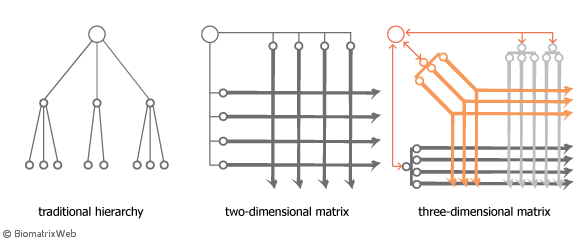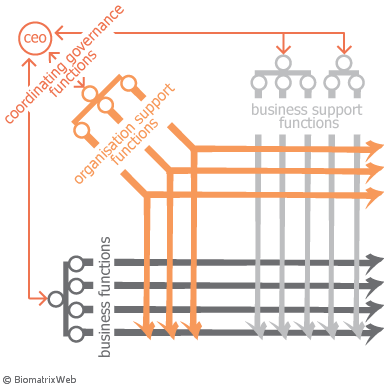optimal organisational structure
Although the traditional hierarchy of the industrial age is rapidly disappearing, the new organisational structure of the information age has not emerged yet – in spite of the significant amount of experimentation with structural changes.
Matrix management has been used in many organisations for decades, but it gives rise to problems. The conventional organisational matrix is typically depicted as a two-dimensional grid: horizontal lines represent production lines, vertical lines represent business functions.
The three-dimensional organisational matrix of Biomatrix systems theory is a refinement in the evolution of matrix management. It solves the problems arising from conventional matrix management.

three-dimensional matrix overview
The three-dimensional organisational matrix model comes from Biomatrix systems theory.
This theory distinguishes between entity systems (e.g. an organisation, person, society, cell, planet) and activity systems (i.e. the functions of an entity system). It also postulates that entity systems have a three-fold organisation, because they consist of outward, inward and self-directed activity systems. This three-fold organisation gives rise to a three-dimensional organisational matrix structure (abbreviated as 3D matrix).
The model was scientifically argued in 19941 and has been taught in MBA and post graduate OD programmes since. It has been implemented in large and small, national and international, private, public sector and non-government organisations since the late 1990s.
The concept of the three-dimensional organisational matrix makes sense to managers and they see it as the ideal organisational structure for the information age. It meets the key challenge of facilitating continuous learning-based internal change in response to external change. It is a relatively simple tool, which is nevertheless capable of handling enormous complexity. It embodies all advantages of the traditional organisational hierarchy and the flat, throughput-based organisation, while at the same time transforming their disadvantages to advantages. It also allows optimal coordination between all functions as well as maximum flexibility and autonomy of individual functions. It optimises learning within and between functions and it optimises interaction with stakeholders and the wider environment throughout the organisation. It is a web within the wider web of the economy, society and nature.
We therefore believe that the three-dimensional matrix as described by Biomatrix systems theory is the organisational structure of the information age.
shift from two to three-dimensional matrix
The model of the two-dimensional matrix is well known in business and public sector organisations and has been used by project-based organisations to coordinate their projects. However, problems arise because some of the specialised or line functions are not only interfacing with the business functions but also with each other. By distinguishing them into business and organisation support functions (i.e. inward and self-directed functions according to Biomatrix systems theory), a three-dimensional matrix is created which dissolves those problems.
Another problem experienced with any matrix management (two or three-dimensional) is associated with worldview. In order to make it viable, matrix management requires a shift to a process-based worldview, which includes thinking in terms of multiple functions, multiple authorities, multiple standards and multiple connections to other systems. The process perspective must become an integrated perspective at all organisational levels.
If matrix management is married to a process worldview, the perception of the matrix becomes one of a process matrix that extends along each of its lines into the environment. It meets the demand for an information age organisation that was expressed by Davis and Meyer2 as: “The structure of the economic web … should be the same as the structure of an adaptable organisation web”.
Biomatrix systems theory is a web-based systems theory. It suggests that the universe is organised as a web of activity systems, that an economy is organised as a web, that an organisation ought to be organised as a web and that each individual member within an organisation is a web. It also distinguishes between the webs of natural, societal and technical systems and emphasises their multi-dimensional interaction.
organisation of the three-dimensional matrix

Translating the generic Biomatrix terminology of outward, inward and self-directed activity systems into management terminology is somewhat difficult, as there is no coherent use of terms. We have therefore introduced our own terms.
The three types of activity systems within an organisational matrix and their respective functions are the following:
business functions (dark grey lines)
We refer to the outward directed activity systems of an organisation as business functions. In the management literature they are often referred to as business processes or throughput functions.
The business functions are concerned with the provision of goods and services to the external customers of the organisation. They express the main purpose of the organisation, why the business exists.
Some organisations have only one product or service and therefore only one business function, while other organisations have several. These are depicted as parallel lines. For example, a motorcar manufacturer could have parallel process lines for different types of cars (e.g. passenger cars, heavy duty vehicles, microbuses, sports cars, etc.). Other examples are the different degree courses and research programs at a university, the different types of projects in an engineering company, different shops in a region, different types of services of a consultant, etc.
The provision of a good or service involves processing, namely the transformation of inputs into outputs. This occurs in phases. For example, the business of producing cars involves procurement of parts, the assembly of different parts into a car, other processing (e.g. painting), as well as marketing, selling and delivery. Likewise, a university course involves different disciplines and subjects. Each phase is a sub-activity system or sub-function with its own expertise or functional specialisation. These are provided by the business support systems.
business support functions (light grey lines)
We refer to the inward-directed activity systems of an organisation as business support functions. They are concerned with providing resources (e.g. human, material, technological, knowledge and energy) for the different specialisations required by the business functions. The management literature refers to them as specialised business functions or line functions.
In a matrix context, the business support functions also ensure coordination across the business functions within each sub-function (such as procurement, production, marketing, distributing, etc.). They are also responsible for
- specialisation related coordination between business activities (e.g. standardising procurement, or coordinating marketing across all business functions)
- specialisation related training, development and learning
- specialisation related problem solving
- development of norms, standards and guidelines for professional behaviour and functioning as appropriate to the area of specialisation
- evaluation of professional performance, benchmarking and auditing related to the area of specialisation
- procurement of specialised knowledge, building networks of subcontractors, coordination of business support related outsourcing
- business support related environmental scanning.
The business support lines differ from industry to industry. As mentioned in the examples above (i.e. car manufacturer, university, school, engineering company, retail chain and consultancy), the business support activities could be the design, manufacturing, assembly, procurement, marketing and distribution of the car manufacturer; the different scientific disciplines of a university; the different subjects taught at a school; the different types of engineering functions (e.g., electrical, civil, mechanical, electronic), as well as the workshop, procurement, designing, marketing / tendering functions of an engineering company; the various merchandising functions, packing, transporting, etc. which supply individual shops in a region; the different types of specialisation of a management consulting firm such as HR, finance, organisational development, knowledge management, IT systems, etc.
organisation support functions (orange lines)
We refer to the self-directed activity systems of an organisation as organisation support functions. They are concerned with establishing and maintaining the organisation as an entity.
Each organisation support function provides support to all functions, business, business support and other organisation support functions. For example, corporate finance provides budgets and accounting services to all functions (even to itself). Likewise, the IT function coordinates the flow of data within and between all functions (including its own data flow). Other organisation support functions are administration, knowledge management, human resource development, organisational development, legal services and auditing, amongst others.
The organisation support functions tend to be similar across industries. For example, labour and tax laws apply to all industries. Human resource management, corporate finance and IT practices are similar (if not the same) in different industries. If there are additional industry specific regulations, these tend to be adjustments to the generic function, rather than representing a fundamentally different one.
The management literature does not generally distinguish between inward and self-directed functions and refers to them as specialist functions or line functions. In organisational praxis however, there is a growing trend to centralise organisation support services and provide them to all business and functional units according to service level agreements.
coordinating governance functions (red lines)
All functions have their own internal governance, as well as being governed by coordinating organisational governance. These coordinating governance functions are depicted by the red lines that lead upwards to the CEO.
Coordinating governance are self-referring activity systems and include planning, performance management and various regulatory activities. They coordinate all functions within the organisation, the business, business support and organisation support functions.
references
1 Dostal, E. and Jaros, GG 1994. The teleonics view of a matrix organization. In New Systems Thinking and Action for a New Century, B. Brady and L. Peeno, Editors. International Society for the Systems Sciences: Louisville, Kentucky, USA, 981-990.
2 Davis, S and Meyer, C. 1998. Blur. The speed of change in the connected economy. New York: Warner Books. p. 118.
This article is abstracted from Biomatrix: A Systems Approach to Organisational and Societal Change, by E. Dostal in collaboration with A. Cloete and G. Jaros. Published by BiomatrixWeb in 2005.
Note on terminology: In the book we use the terms business activity system, business support activity system and organisation support activity system. In this article we use the term function instead of activity system.
about biomatrixweb
BiomatrixWeb offers education and development programmes guiding the client organisation to seamlessly transform itself into a learning organisation structured as a three-dimensional matrix.
learn more
To learn more about Biomatrix systems theory in general, visit biomatixtheory.com and browse the free presentation.
To learn more about application of Biomatrix systems theory to organisational development and change management, consider purchasing one of our books, enrol into one of our online management education courses or facilitate one of our transformation programmes in your organisation.

